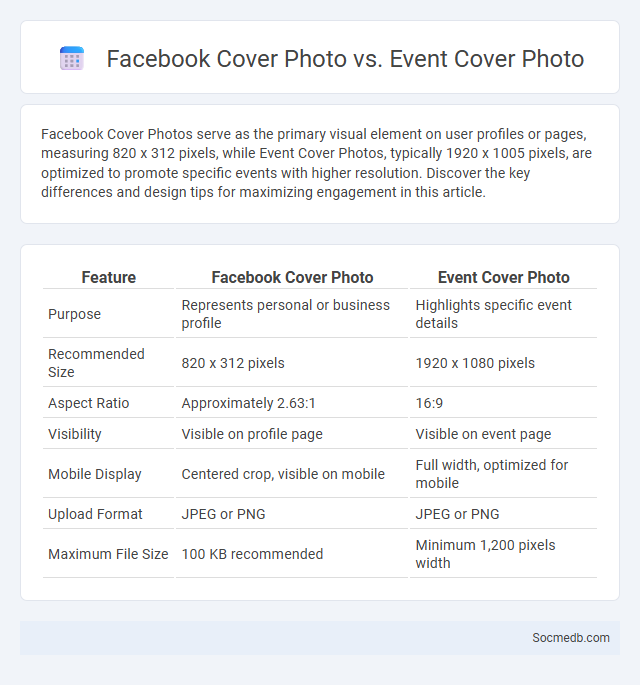
Photo illustration: Facebook Cover Photo vs Event Cover Photo
Facebook Cover Photos serve as the primary visual element on user profiles or pages, measuring 820 x 312 pixels, while Event Cover Photos, typically 1920 x 1005 pixels, are optimized to promote specific events with higher resolution. Discover the key differences and design tips for maximizing engagement in this article.
Table of Comparison
| Feature | Facebook Cover Photo | Event Cover Photo |
|---|---|---|
| Purpose | Represents personal or business profile | Highlights specific event details |
| Recommended Size | 820 x 312 pixels | 1920 x 1080 pixels |
| Aspect Ratio | Approximately 2.63:1 | 16:9 |
| Visibility | Visible on profile page | Visible on event page |
| Mobile Display | Centered crop, visible on mobile | Full width, optimized for mobile |
| Upload Format | JPEG or PNG | JPEG or PNG |
| Maximum File Size | 100 KB recommended | Minimum 1,200 pixels width |
Understanding Facebook Cover Photo
Your Facebook cover photo serves as a powerful visual representation of your personal brand or business identity, with optimal dimensions of 820 by 312 pixels to ensure clarity across devices. Utilizing high-resolution images and aligning key elements within the safe zone prevents crucial content from being cropped, enhancing user engagement and professional appearance. Crafting a cover photo that resonates with your target audience supports increased interaction and brand recognition on your Facebook profile.
What is an Event Cover Photo?
An event cover photo is a visually engaging image used as the main banner on social media event pages to capture attention and convey the event's theme or purpose. It typically includes essential details such as event name, date, location, and branding elements to enhance recognition and encourage attendance. Optimizing the event cover photo with relevant keywords and high-quality visuals improves event visibility and attendee engagement on platforms like Facebook, LinkedIn, and Instagram.
General Overview: Facebook Cover Photo vs Event Cover Photo vs Regular Cover Photo
Facebook cover photos serve distinct functions based on their placement: a general Facebook cover photo represents the overall personality of a profile or page with dimensions typically set at 820 x 312 pixels for desktops and 640 x 360 pixels for mobile. Event cover photos are sized at 1920 x 1005 pixels, designed to promote specific occasions with bold visuals and concise information to capture attention effectively. Regular cover photos, often interchangeable with general covers, maintain brand consistency or personal identity but may be optimized differently depending on the platform's use case and audience engagement goals.
Dimensions and Size Requirements
Social media platforms have specific dimensions and size requirements for images and videos to ensure optimal display quality and user engagement. For instance, Instagram profile pictures should be 320x320 pixels, while Facebook cover photos need to be 820x312 pixels for desktop and 640x360 pixels for mobile. Adhering to these platform-specific size guidelines prevents content from appearing pixelated or cropped, enhancing visual impact across devices.
Design Best Practices for Each Cover Type
Design best practices for social media cover types emphasize tailored dimensions and visual consistency across platforms such as Facebook, Twitter, and LinkedIn. High-resolution images, minimal text, and brand-aligned color schemes optimize engagement and ensure clarity on devices ranging from desktops to smartphones. Incorporating balanced focal points and clear calls to action enhances user interaction and strengthens brand identity on each cover type.
Purpose and Impact: Brand Image vs Event Promotion
Social media serves dual purposes by enhancing brand image through consistent messaging and visual identity while also driving event promotion with timely updates and engagement strategies. Your focused efforts on content tailored to brand values build long-term loyalty, whereas event-centric campaigns generate immediate buzz and attendance. Optimizing both approaches ensures a balanced digital presence that strengthens reputation and boosts real-time interaction.
Placement and Visibility Differences
Social media placement varies significantly between platforms, influencing content visibility and user engagement. Organic posts typically have limited reach compared to paid placements, which are strategically positioned in newsfeeds, stories, or sidebars to maximize exposure. Algorithm-driven visibility prioritizes content relevance, user interaction, and timing, making targeted placements essential for effective social media marketing campaigns.
Customization and Editing Features
Social media platforms offer extensive customization and editing features that empower users to personalize their profiles, posts, and content extensively. Tools such as advanced photo and video editors, customizable templates, and filter options enhance user creativity and engagement. These features drive higher user interaction rates and foster unique digital identities across platforms like Instagram, TikTok, and Facebook.
Common Mistakes to Avoid
Common mistakes to avoid on social media include oversharing personal information, which can compromise privacy and security. Ignoring audience engagement by failing to respond to comments and messages often leads to diminished follower trust and retention. Posting inconsistent or irrelevant content can reduce brand credibility and limit reach across platforms like Instagram, Facebook, and Twitter.
Choosing the Right Cover Photo for Your Needs
Selecting the right cover photo for your social media profile significantly impacts your brand's visual identity and audience engagement. Prioritize high-resolution images that reflect your core message, target audience, and platform-specific dimensions such as 820 x 312 pixels for Facebook or 1500 x 500 pixels for Twitter. Incorporate colors and elements consistent with your branding to enhance recognition and professionalism across channels.
 socmedb.com
socmedb.com